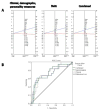Individualized relapse prediction: Personality measures and striatal and insular activity during reward-processing robustly predict relapse
- PMID: 25977206
- PMCID: PMC4458160
- DOI: 10.1016/j.drugalcdep.2015.04.018
Individualized relapse prediction: Personality measures and striatal and insular activity during reward-processing robustly predict relapse
Erratum in
-
Corrigendum to "Individualized relapse prediction: Personality measures and striatal and insular activity during reward-processing robustly predict relapse" [Drug and Alcohol Dependence 152 (2015) 93-101].Drug Alcohol Depend. 2017 Jun 1;175:255. doi: 10.1016/j.drugalcdep.2017.03.003. Epub 2017 Apr 18. Drug Alcohol Depend. 2017. PMID: 28431752 Free PMC article. No abstract available.
Abstract
Background: Nearly half of individuals with substance use disorders relapse in the year after treatment. A diagnostic tool to help clinicians make decisions regarding treatment does not exist for psychiatric conditions. Identifying individuals with high risk for relapse to substance use following abstinence has profound clinical consequences. This study aimed to develop neuroimaging as a robust tool to predict relapse.
Methods: 68 methamphetamine-dependent adults (15 female) were recruited from 28-day inpatient treatment. During treatment, participants completed a functional MRI scan that examined brain activation during reward processing. Patients were followed 1 year later to assess abstinence. We examined brain activation during reward processing between relapsing and abstaining individuals and employed three random forest prediction models (clinical and personality measures, neuroimaging measures, a combined model) to generate predictions for each participant regarding their relapse likelihood.
Results: 18 individuals relapsed. There were significant group by reward-size interactions for neural activation in the left insula and right striatum for rewards. Abstaining individuals showed increased activation for large, risky relative to small, safe rewards, whereas relapsing individuals failed to show differential activation between reward types. All three random forest models yielded good test characteristics such that a positive test for relapse yielded a likelihood ratio 2.63, whereas a negative test had a likelihood ratio of 0.48.
Conclusions: These findings suggest that neuroimaging can be developed in combination with other measures as an instrument to predict relapse, advancing tools providers can use to make decisions about individualized treatment of substance use disorders.
Keywords: Methamphetamine dependence; Neuroimaging; Relapse; Reward; Risk prediction; Striatum.
Published by Elsevier Ireland Ltd.
Conflict of interest statement
Figures



References
-
- Baker A, Boggs TG, Lewin TJ. Randomized controlled trial of brief cognitive-behavioural interventions among regular users of amphetamine. Addiction. 2001;96:1279–1287. - PubMed
-
- Bechara A. Disturbances of emotion regulation after focal brain lesions. Intl Rev Neurobiol. 2004;62:159–193. - PubMed
-
- Beck AT, Ward CH, Mendelson M, Mock J, Erbaugh J. An inventory for measuring depression. Arch Gen Psychiatry. 1961;4:561–571. - PubMed
Publication types
MeSH terms
Substances
Grants and funding
LinkOut - more resources
Full Text Sources
Other Literature Sources
Medical

